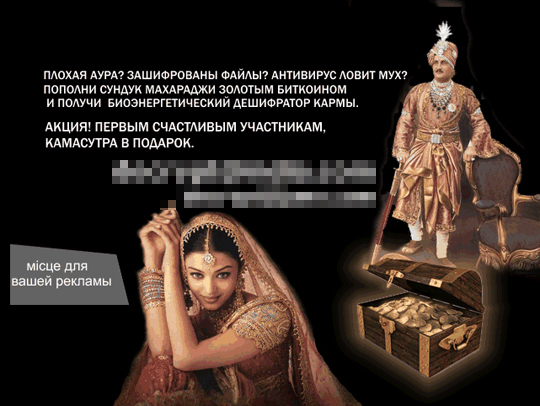TROJ_CRYPAURA.B
Trojan-Ransom.Win32.Aura.ao(Kaspersky), Win32/Filecoder.DG trojan(Eset)
Windows


Threat Type: Trojan
Destructiveness: No
Encrypted: Yes
In the wild: Yes
OVERVIEW
Spammed via email, Downloaded from the Internet
This ransomware variant appends id-{id}_decrypt@india.com to its encrypted files.
This Trojan arrives as an attachment to email messages spammed by other malware/grayware or malicious users. It arrives on a system as a file dropped by other malware or as a file downloaded unknowingly by users when visiting malicious sites.
It connects to certain websites to send and receive information. It deletes itself after execution.
TECHNICAL DETAILS
2,404,352 bytes
EXE
No
21 Nov 2014
Connects to URLs/IPs, Steals information, Displays graphics/image
Arrival Details
This Trojan arrives as an attachment to email messages spammed by other malware/grayware or malicious users.
It arrives on a system as a file dropped by other malware or as a file downloaded unknowingly by users when visiting malicious sites.
Installation
This Trojan drops the following files:
- %Application Data%\aura.bmp - ransom message
- %Start Menu%\Programs\Startup\aura.bmp - ransom message (for Windows Vista and higher)
- %User Startup%\aura.bmp - ransom message (for Windows XP and lower)
(Note: %Application Data% is the Application Data folder, where it usually is C:\Documents and Settings\{user name}\Application Data on Windows 2000, Windows Server 2003, and Windows XP (32- and 64-bit); C:\Users\{user name}\AppData\Roaming on Windows Vista (32- and 64-bit), Windows 7 (32- and 64-bit), Windows 8 (32- and 64-bit), Windows 8.1 (32- and 64-bit), Windows Server 2008, and Windows Server 2012.. %Start Menu% is the Start Menu folder, where it usually is C:\Documents and Settings\{user name}\Start Menu on Windows 2000, Windows Server 2003, and Windows XP (32- and 64-bit); C:\Users\{user name}\AppData\Roaming\Microsoft\Windows\Start Menu on Windows Vista (32- and 64-bit), Windows 7 (32- and 64-bit), Windows 8 (32- and 64-bit), Windows 8.1 (32- and 64-bit), Windows Server 2008, and Windows Server 2012.. %User Startup% is the current user's Startup folder, which is usually C:\Windows\Profiles\{user name}\Start Menu\Programs\Startup on Windows 98 and ME, C:\WINNT\Profiles\{user name}\Start Menu\Programs\Startup on Windows NT, and C:\Documents and Settings\{User name}\Start Menu\Programs\Startup.)
Autostart Technique
This Trojan drops the following file(s) in the Windows User Startup folder to enable its automatic execution at every system startup:
- %Start Menu%\Programs\Startup\{malware file name}.exe - for Windows Vista and higher
- %User Startup%\{malware file name}.exe - for Windows XP and lower
(Note: %Start Menu% is the Start Menu folder, where it usually is C:\Documents and Settings\{user name}\Start Menu on Windows 2000, Windows Server 2003, and Windows XP (32- and 64-bit); C:\Users\{user name}\AppData\Roaming\Microsoft\Windows\Start Menu on Windows Vista (32- and 64-bit), Windows 7 (32- and 64-bit), Windows 8 (32- and 64-bit), Windows 8.1 (32- and 64-bit), Windows Server 2008, and Windows Server 2012.. %User Startup% is the current user's Startup folder, which is usually C:\Windows\Profiles\{user name}\Start Menu\Programs\Startup on Windows 98 and ME, C:\WINNT\Profiles\{user name}\Start Menu\Programs\Startup on Windows NT, and C:\Documents and Settings\{User name}\Start Menu\Programs\Startup.)
Information Theft
This Trojan gathers the following data:
- Computer name
- Machine GUID
Other Details
This Trojan connects to the following website to send and receive information:
- http://{BLOCKED}ndia.com/open/script.php
- http://{BLOCKED}ndia.com/close/script.php
It encrypts files with the following extensions:
- 1cd
- 3gp
- 7z
- arj
- avi
- cdr
- cer
- cpt
- csv
- db3
- dbf
- doc
- docx
- dt
- dwg
- gzip
- jpeg
- jpg
- key
- m2v
- mdb
- mkv
- mov
- mpeg
- ods
- odt
- ppsx
- ppt
- pptx
- pwm
- rar
- raw
- rtf
- temp
- tib
- wab
- xls
- xlsx
- zip
It renames encrypted files using the following names:
- {original file name and extension}.id-{id}_decrypt@india.com
It deletes itself after execution.
NOTES:
This trojan may display the following message at every startup:

It traverses the following drives to encrypt files:
- c:\
- d:\
- e:\
- f:\
- g:\
- h:\
- i:\
- j:\
- k:\
- l:\
- m:\
- n:\
- o:\
- q:\
- r:\
- s:\
- t:\
- u:\
- v:\
- w:\
- x:\
- y:\
- z:\
It avoids encrypting files located in the following folder:
- Program Data
- Program Files
- Program Files (x86)
- Windows
SOLUTION
9.700
Step 1
Before doing any scans, Windows XP, Windows Vista, and Windows 7 users must disable System Restore to allow full scanning of their computers.
Step 2
Note that not all files, folders, and registry keys and entries are installed on your computer during this malware's/spyware's/grayware's execution. This may be due to incomplete installation or other operating system conditions. If you do not find the same files/folders/registry information, please proceed to the next step.
Step 3
Search and delete these files
- %Application Data%\aura.bmp
- %Start Menu%\Programs\Startup\aura.bmp - for Windows Vista and higher
- %User Startup%\aura.bmp - for Windows XP and lower
Step 4
Scan your computer with your Trend Micro product to delete files detected as TROJ_CRYPAURA.B. If the detected files have already been cleaned, deleted, or quarantined by your Trend Micro product, no further step is required. You may opt to simply delete the quarantined files. Please check this Knowledge Base page for more information.
NOTES:
Restore the encrypted files by this malware from backup. Note that the encrypted files have the extension .id-{id}_decrypt@india.com.
Did this description help? Tell us how we did.


